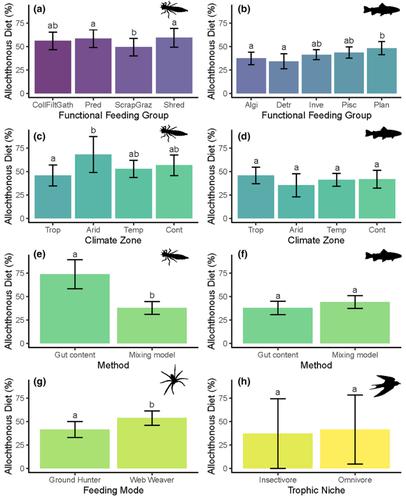当前位置:
X-MOL 学术
›
Ecol. Lett.
›
论文详情
Our official English website, www.x-mol.net, welcomes your
feedback! (Note: you will need to create a separate account there.)
Global patterns of allochthony in stream–riparian meta‐ecosystems
Ecology Letters ( IF 7.6 ) Pub Date : 2024-03-12 , DOI: 10.1111/ele.14401 Daniel C Allen 1 , James Larson 2 , Christina A Murphy 3 , Erica A Garcia 4 , Kurt E Anderson 5 , Michelle H Busch 6 , Alba Argerich 7 , Alice M Belskis 1 , Kierstyn T Higgins 1 , Brooke E Penaluna 8 , Veronica Saenz 9 , Jay Jones 10 , Matt R Whiles 11
Ecology Letters ( IF 7.6 ) Pub Date : 2024-03-12 , DOI: 10.1111/ele.14401 Daniel C Allen 1 , James Larson 2 , Christina A Murphy 3 , Erica A Garcia 4 , Kurt E Anderson 5 , Michelle H Busch 6 , Alba Argerich 7 , Alice M Belskis 1 , Kierstyn T Higgins 1 , Brooke E Penaluna 8 , Veronica Saenz 9 , Jay Jones 10 , Matt R Whiles 11
Affiliation

|
Ecosystems that are coupled by reciprocal flows of energy and nutrient subsidies can be viewed as a single “meta‐ecosystem.” Despite these connections, the reciprocal flow of subsidies is greatly asymmetrical and seasonally pulsed. Here, we synthesize existing literature on stream–riparian meta‐ecosystems to quantify global patterns of the amount of subsidy consumption by organisms, known as “allochthony.” These resource flows are important since they can comprise a large portion of consumer diets, but can be disrupted by human modification of streams and riparian zones. Despite asymmetrical subsidy flows, we found stream and riparian consumer allochthony to be equivalent. Although both fish and stream invertebrates rely on seasonally pulsed allochthonous resources, we find allochthony varies seasonally only for fish, being nearly three times greater during the summer and fall than during the winter and spring. We also find that consumer allochthony varies with feeding traits for aquatic invertebrates, fish, and terrestrial arthropods, but not for terrestrial vertebrates. Finally, we find that allochthony varies by climate for aquatic invertebrates, being nearly twice as great in arid climates than in tropical climates, but not for fish. These findings are critical to understanding the consequences of global change, as ecosystem connections are being increasingly disrupted.
中文翻译:

河流-河岸元生态系统中异地生物的全球模式
通过能量和营养补贴的相互流动耦合起来的生态系统可以被视为一个单一的“元生态系统”。尽管存在这些联系,补贴的相互流动却非常不对称,并且具有季节性波动。在这里,我们综合了有关河流-河岸元生态系统的现有文献,以量化生物体补贴消费量的全球模式,称为“异地生物”。这些资源流很重要,因为它们可以构成消费者饮食的很大一部分,但可能会因人类对溪流和河岸地区的改造而中断。尽管补贴流量不对称,但我们发现河流和河岸消费者异地恋是等效的。尽管鱼类和溪流无脊椎动物都依赖季节性脉冲的异地资源,但我们发现只有鱼类的异地资源随季节变化,夏季和秋季的异地资源量几乎是冬季和春季的三倍。我们还发现,消费者的异地动物随水生无脊椎动物、鱼类和陆生节肢动物的摄食性状而变化,但陆生脊椎动物则不然。最后,我们发现水生无脊椎动物的异地性因气候而异,干旱气候下的异地性几乎是热带气候下的两倍,但鱼类则不然。这些发现对于理解全球变化的后果至关重要,因为生态系统的联系正日益受到破坏。
更新日期:2024-03-12
中文翻译:

河流-河岸元生态系统中异地生物的全球模式
通过能量和营养补贴的相互流动耦合起来的生态系统可以被视为一个单一的“元生态系统”。尽管存在这些联系,补贴的相互流动却非常不对称,并且具有季节性波动。在这里,我们综合了有关河流-河岸元生态系统的现有文献,以量化生物体补贴消费量的全球模式,称为“异地生物”。这些资源流很重要,因为它们可以构成消费者饮食的很大一部分,但可能会因人类对溪流和河岸地区的改造而中断。尽管补贴流量不对称,但我们发现河流和河岸消费者异地恋是等效的。尽管鱼类和溪流无脊椎动物都依赖季节性脉冲的异地资源,但我们发现只有鱼类的异地资源随季节变化,夏季和秋季的异地资源量几乎是冬季和春季的三倍。我们还发现,消费者的异地动物随水生无脊椎动物、鱼类和陆生节肢动物的摄食性状而变化,但陆生脊椎动物则不然。最后,我们发现水生无脊椎动物的异地性因气候而异,干旱气候下的异地性几乎是热带气候下的两倍,但鱼类则不然。这些发现对于理解全球变化的后果至关重要,因为生态系统的联系正日益受到破坏。

















































 京公网安备 11010802027423号
京公网安备 11010802027423号